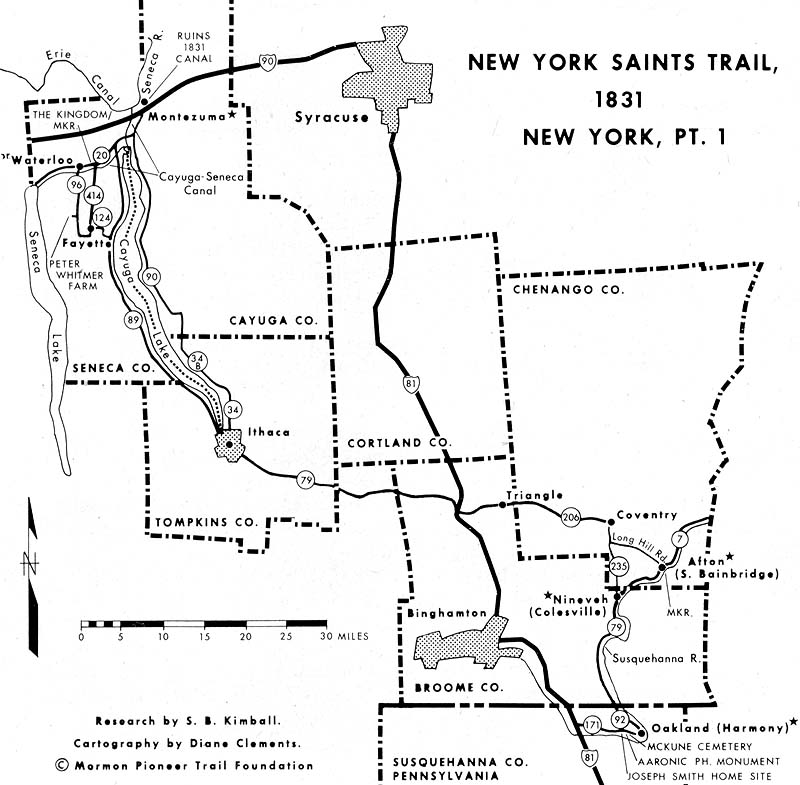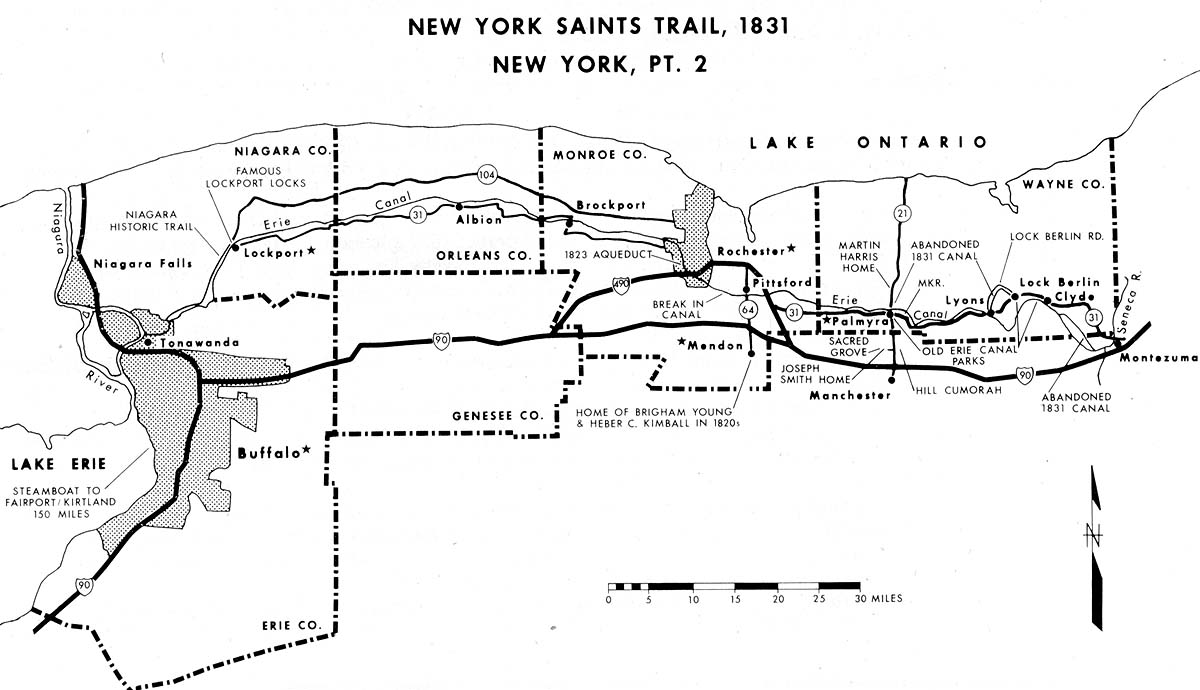“The First Road West: From New York to Kirtland, 1831,” Ensign, Jan. 1979, 29
The First Road West:
From New York to Kirtland, 1831
This map and commentary is first in a series to enrich the Church’s Doctrine and Covenants classes, 1978–80; the compiled installments will appear in a book, Discovering Mormon Trails: New York to California, 1831–68, Deseret Book.
The Church was barely established in western New York and northern Pennsylvania before the Lord commanded the Prophet Joseph Smith, during December 1830 and January 1831, to “go to the Ohio.” (See D&C 37:1; D&C 38:32.) He and Emma and a few others left Fayette Township, New York, during January 1831. Those left behind—nearly two hundred—formed themselves into three groups and prepared to follow the Prophet to Kirtland, Ohio, where the Church was growing rapidly.
The first group to leave was the Colesville Branch. Although a few left separately, most Colesville members, a group of about sixty, departed early in April 1831 under the leadership of Newel Knight. They followed the Old State Road north of Binghamton to Ithaca and then went by boat up Cayuga Lake, down the Cayuga and Seneca Canal for eleven miles, and on the Erie Canal for over 160 miles to Buffalo.
From Buffalo they took a Lake Erie steamer 150 miles to Fairport, Ohio, only eleven miles from Kirtland, where they arrived safely in May. Theoretically at least, the Saints could have made the entire trip from Ithaca to Buffalo and even on to Ohio without once touching land.
As the accompanying map shows, the Saints from Colesville (now Nineveh) went overland via South Bainbridge (now Afton) where Joseph and Emma Smith were married and Joseph had been arrested for preaching about the Book of Mormon. In front of the Afton Fair Grounds is a marker telling of their marriage. (On this map, black dots indicate Communities that existed in 1831; stars show communities of interest.)

New York Saints Trail, 1831
New York, Pt. 1
The second group, of about eighty Saints, embarked for Buffalo near Waterloo, Seneca County, New York, via the Cayuga and Seneca Canal and the Erie Canal. Part of this Waterloo group came from Fayette Township, where the Church had been organized 6 April 1830. They gathered at the Smith home two miles east of Waterloo. The Waterloo-Fayette company was divided into two parts, the first led by Lucy Mack Smith, the second by Thomas B. Marsh. They departed about May 3, traveling on the Cayuga and Seneca Canal, which ran in front of the Smith home and connected with the Erie Canal at Montezuma. They arrived in Buffalo five days later and in Kirtland that same month.
A third group, about fifty members from Palmyra, New York, left May 27 for Buffalo on the Erie Canal which ran through their village. Led by Martin Harris, they arrived in Kirtland in June.

New York Saints Trail, 1831
New York, Pt. 2
The voyages of these three groups were generally uneventful, except that near Pittsford, Mother Smith’s company was delayed by a break in the canal wall, and ice at Buffalo held up the Colesville Saints for some days.
It is easy and pleasant today to follow the route of these first migrants west. Good roads lead from Colesville to Ithaca. From highway 89 the traveler has a beautiful view of Cayuga Lake and convenient access to the village of Fayette and the Peter Whitmer farm in Fayette Township, where the Church was organized.
Late in 1830 Joseph Smith’s parents had left Manchester because of persecution and settled in Waterloo Township, two miles east of the village of Waterloo, where their son had previously established the small “Kingdom” branch. Today, a large Kingdom Shopping Center and a historic marker one mile east of the Center commemorate this vanished village.
This route includes other sites of interest to students of Mormon history. In the community of Montezuma, ruins of the original Erie Canal are plainly visible. Since the first dredging, there have been three different Erie canals. The first, which the Saints used, is usually referred to affectionately as “Clinton’s Ditch.” Forty feet wide and four feet deep, it was built between 1817 and 1825. During the 1840s and 1850s most of this canal was enlarged to a width of seventy feet and a depth of seven feet. During the early twentieth century the canal was again enlarged—to seventy-five feet wide and twelve feet deep—and rechristened the New York State Barge–Erie Canal.
All three canals followed the same general route, so only bits and pieces of Clinton’s Ditch are still visible. Some of the best preserved and accessible sections are at Montezuma, between Lock Berlin and Lyon, and, fortuitously, at Palmyra.
At Rochester, under South Street, is the 802-foot stone aqueduct, built in 1823, which carried the Saints across the Genesee River. Another historic site is the famous locks at Lockport where in the 1830s, as today, a series of five locks raised and lowered canal boats fifty-six feet. From Lockport the lovely Niagara Historic Trail leads to Buffalo via Tonawanda.